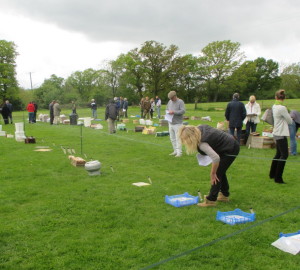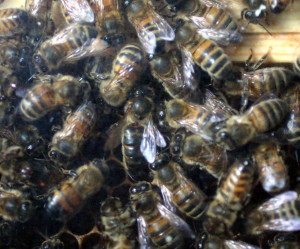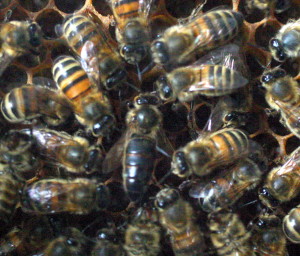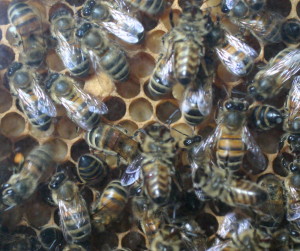Blog – bees, beekeeping & other sticky subjects
Will she or won’t she? (She did!)
The observation hive has been in action for a few weeks now — and is as mysterious as ever.
There’s a queen, a retinue, but no brood or eggs yet …
On 17 May, I believe the virgin queen emerged from her cell. She has been tricky to see because she is so dark, but I’ve seen at regular intervals.
Now, on Day 25, she appears to be mated and is going through the motions of egg-laying — but no eggs are yet visible.
In fact she has been going through the motions of egg-laying since I first saw her! Practice makes perfect , I suppose.
The books say that mating usually takes place 6-10 days after emergence and that she will start laying 2-3 days after that. Obviously she is behind schedule!
Nonetheless I have hopes that she is now mated and getting ready to lay because of the respect paid to her by her ever-changing retinue. She also looks a little plumper!
Her workers obviously think she has The Right Stuff.
At last! She has successfully mated and is now laying. She first emerged on 17 May, but she didn’t start laying until 7 June at the earliest — and not really in earnest until several days later.
Here you can see the developing larvae — and one sealed cell, though I’m not convinced that it contains a developing honeybee.
Turlough, Vita’s Guest Beekeeper Blogger
Hangout on bee diseases
Last month, Sebastian Owen appeared in a Hangout (public video conference call) about bee diseases, specifically Nosema and Chronic Bee Paralysis.
On the hangout, organised by Bee Craft, the UK’s beekeeping magazine, Sebastian was joined by Julian Routh, BBKA and Seasonal Bee Inspector, James Dearsley of Bee Craft and Rhodri Powell of the Welsh beekeepers
The video is about one-hour long, and packs in lots of useful information.
You can see more of the monthly Bee Craft Hangouts here.
Swarm in search of company, but not a home
As I approached a newish apiary last weekend, I wondered where any swarms might choose to hang up. I had never seen a swarm leave that apiary before. I was busy working on the final hive and happened to glance up …
The swarm wasn’t even from my apiary and it had chosen to settle on a tree rather than in a brood box right by it! It must have been there for quite a while as it had left quite a bit of wax on the tree trunk — and the wax traces also showed how the swarm was gradually moving up the trunk.
It was safely hived and is drawing comb to try to quarantine any disease it might be carrying in its honey. That comb will be melted down and the bees can start afresh in a new hive.
I have no idea of the origin of the swarm , but clearly it wanted company by settling in my apiary.
UPDATE 9 June 2015 The swarm was homed by a new beekeeper and is apparently doing well with the queen laying already. A further inspection of my own hives showed conclusively that it wasn’t from my apiary.
Turlough, Vita’s Guest Beekeeper Blogger
What a lot of bee auction bargains
 Last Saturday saw the annual Meon Valley Beekeeping Auction in Hampshire, England.
Last Saturday saw the annual Meon Valley Beekeeping Auction in Hampshire, England.
Two hundred lots were up for auction, some mainstream some quirky, and many bargains
- a vintage honey extractor (too vintage and with too much tin plate to fetch more than £1!)
- branding iron (for hives rather than bees, I presume)
- selection of Langstroth hives (not that popular in Britain, but common in Hampshire because of its preference by a beekeeping college a couple of decades ago).
- two heather presses (one antique) emphasising the location of the auction as being close to the ling heather of the New Forest
- and a no longer manufactured Strainaway but very popular system for dealing with oil seed rape. It fetched £80, I think.
As always the lots that attracted most attention: three colonies of live bees. There appeared to be four bidders seeking the bees and the lots fetched (in order of sale): £130, £165, £180 or approx €181, €229, and €250, or $203, $257 and $281 respectively.
Honeybee health was a top priority. The live bees had been inspected for disease and several lots of bees were refused because they had been submitted too late for inspection. Much if not all of the hive equipment had been scorched to nullify any potential bee disease spread.
 And of course there was something that everyone came for: the superb soups, bacon butties and cakes — all delicious and also available at bargain prices.
And of course there was something that everyone came for: the superb soups, bacon butties and cakes — all delicious and also available at bargain prices.
Turlough
Vita’s Guest Beekeeper Blogger
Vita in Russia
 Svetlana Pantyukhina, manager of Vita CIS in Russia, tells us that there are about five million colonies of bees in modern Russia. Professional beekeeping is common with some of the biggest operations managing between 1000 and 5000 colonies. But everyone has been hit hard by the Rouble exchange rate crisis and times are difficult.
Svetlana Pantyukhina, manager of Vita CIS in Russia, tells us that there are about five million colonies of bees in modern Russia. Professional beekeeping is common with some of the biggest operations managing between 1000 and 5000 colonies. But everyone has been hit hard by the Rouble exchange rate crisis and times are difficult.
Varroa, Nosema and viruses are the chief disease concerns and have been exacerbated over the past decade by honeybee imports from neighbouring countries. Government support for beekeeping has decreased and honey prices have dropped, so current economics mean that beekeepers struggle to maintain healthy colonies. One fear is that some beekeepers may be resorting to home-developed and unregulated treatments because of the high import costs.
However some beekeepers – mainly large beefarmers – are showing a growing interest in organic beekeeping. These beekeepers are therefore very interested in Apiguard as an organic Varroa control treatment and Vita Feed Gold for the health benefits it can bring and other Vita products.
One of the prime beekeeping areas in Russia is near the Black Sea, where the warmer climate and mountain herbs and crops produce fine honey. However Varroa resistant to first generation treatments have appeared and beekeepers are facing extra challenges in controlling the mite.
Elsewhere of course, the Russian winter means that honeybees have to be tough to survive. In many areas, they must be insulated and even brought under cover to survive the fierce winter from November to March.




